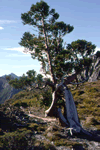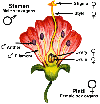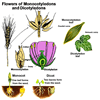Plants have been closely studied throughout history because they are a major source of food, clothing and medicines. Many people living close to the land, such as the Australian Aborigines, have a vast knowledge and understanding of plant types and their uses for food and herbal medicine.
Plants, like animals, are classified on structural features to allow quick and accurate identification.
Vascular plants
The plant kingdom is sub-divided into two major groups.
- The vascular plants (Phylum Tracheophyta) are all the larger plants
which have specialised transport systems (veins) to carry nutrients
and water (See Plant systems
A: Trasnport and support). They have true roots, stems, and leaves.
This group include ferns, clubmosses, conifers, cycads, ginkgoes, and
the well-known angiosperms (flowering plants).
- Non-vascular plants simply absorb nutrients and water through their external surface, which means that they are restricted to aquatic environments or permanently moist areas. They include Phylum Bryophyta (mosses and liverworts). Sometimes the algae (sea weeds) are also classified as non-vascular plants. (They are normally grouped with the Protists. See The five kingdoms of living things). Because non-vascular plants lack specialised transport systems, the size of non-vascular plants growing on land is restricted to a few centimetres.
Further classification of Phylum Tracheophyta
All tracheophytes have true roots, stems, and leaves for transport of
nutrients and water around the plant. Other differences further sub-divide
the phylum into classes.
Ferns (Class Filicopsida)
 Unlike most of the other vascular plants, ferns do not produce
seeds. Instead they develop brown capsules on the undersurface of the
leaves which contain microscopic reproductive spores. These germinate
in moist areas to tiny plants which in turn reproduce to form the familiar
fern. Some examples of ferns are bracken, tree ferns and epiphytic ferns
which grow on tree trunks in rain forests.
Unlike most of the other vascular plants, ferns do not produce
seeds. Instead they develop brown capsules on the undersurface of the
leaves which contain microscopic reproductive spores. These germinate
in moist areas to tiny plants which in turn reproduce to form the familiar
fern. Some examples of ferns are bracken, tree ferns and epiphytic ferns
which grow on tree trunks in rain forests.
 Conifers (Class Coniferopsida)
Conifers (Class Coniferopsida)
Conifers, cycads and ginkgoes are all classed as "gymnosperms"
(from the Greek: naked seeds). Unlike flowering plants, the seeds of gymnosperms
are not protected but lie on the upper surfaces of flat open scales. Later,
in conifers, these scales become the hard, woody cones characteristic
of pines, cypresses, spruces and fir trees.
Flowering plants (Class Angiospermae)
Over 95% of the tracheophytes flower at some time. A flower is a
reproductive structure with specialised organs for the development of
gametes (the "male" pollen and "female" ovules), fertilisation
of gametes, and the formation of a seed coat which may be further protected
by a fleshy fruit (see Plant
Systems C: Reproduction and flowering plants for full details).
The vascular bundles may develop woody tissue which provides support for the stem. The Victorian tree, Eucalyptus regnans, (White Mountain Ash) can grow to over 100 metres in height and is one of the world's largest organisms.
"Monocots" and "Dicots"
 There
are two easily identifiable groups of flowering plants which make interesting
study for students.
There
are two easily identifiable groups of flowering plants which make interesting
study for students.
- Monocotyledons (Monocots) all have parallel
veins in their leaves, flower parts in multiples of three (e.g. six
stamens, three petals, sepals and so on), and only one cotyledon or
seed coat on the seed. Grasses, irises, lilies, orchids and palms are
all Monocots.
- Dicotyledons (Dicots) show a branching
network of veins in the leaves, flower parts in multiples of four or
five and two cotyledons on the seed. Some examples of dicots are geraniums,
heaths, wattles, banksias, peas and tea-tree.
| Copyright owned by the State of Victoria (Department of Education and Early Childhood Development). Used with Permission. |